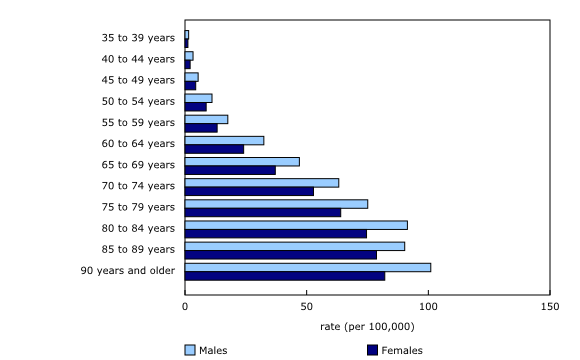Study: Age-specific patterns in the incidence of, and survival from, pancreatic cancer in Canada
Archived Content
Information identified as archived is provided for reference, research or recordkeeping purposes. It is not subject to the Government of Canada Web Standards and has not been altered or updated since it was archived. Please "contact us" to request a format other than those available.
Released: 2017-04-26
Pancreatic cancer is known as one of the deadliest types of cancer and in Canada is associated with the lowest overall five-year survival. This helps explain why pancreatic cancer ranks as the fourth most common cause of cancer death in Canada, despite ranking outside the top 10 most commonly diagnosed types of cancers. While nearly 6% of all cancer deaths in Canada during the period from 2011 to 2013 were attributed to pancreatic cancer, it accounted for just over 2% of all newly diagnosed cancer cases.
Typical of many types of cancer, the rate of diagnosis of pancreatic cancer increases with age. During the period from 2011 to 2013 (the most recent period for which data are available), the incidence rate went from 1.3 per 100,000 among those aged 35 to 39 at diagnosis to 87.2 per 100,000 among those aged 90 and older. One distinguishing feature of pancreatic cancer, however, is that the diagnosis of this disease tends to happen at older ages than is the case for most other cancers. Nearly 8 in 10 cases were diagnosed among those aged 60 or older, and just over one half were 70 or older. Comparable figures for all other cancers combined were nearly 7 in 10 and just over 4 in 10, respectively.
Age-specific rates of pancreatic cancer were generally 20% to 30% higher in males than in females during the period from 2011 to 2013. The overall pancreatic cancer age-standardized incidence rate among males was 14.7 per 100,000, compared to 11.8 among females. The reason behind the higher rates in males is not clear, though lifestyle factors, such as greater tobacco use among males, may play a role.
Survival from pancreatic cancer is low and decreases with age. For those diagnosed with pancreatic cancer from 2005 to 2007, the one-year net survival was highest (48.7%) among those diagnosed between the ages of 15 and 44, and lowest (11.2%) among those aged 85 to 99. For all age groups combined, one-year pancreatic cancer net survival was 23.1%. The low survival for pancreatic cancer results from a combination of factors including late diagnosis, the aggressiveness of the disease and the shortage of curative treatment options.
Note to readers
Annual incidence counts for the diagnosis years 2011 to 2013 were imputed for Quebec, as cancer incidence data for this province were not available beyond 2010.
Net survival was estimated using the cohort approach and relative survival methodology. Analysis was based on cases aged 15 to 99 at diagnosis. Data from the province of Quebec were excluded because the follow-up vital status (dead or alive) of residents of this province diagnosed with cancer was incomplete.
Cancer incidence refers to the number of newly diagnosed cases of cancer.
Age-standardized incidence rates represent the number of new cancer cases per 100,000 people that would have occurred if the population under study had had the same age distribution as the given standard population. Age-standardization allows for comparisons of incidence rates across variables (e.g., sex) that are unaffected by changes in the age distribution of the population.
Net survival is the preferred method for comparing cancer survival in population-based cancer studies. It addresses the issue of differences in mortality due to causes other than pancreatic cancer (that is, the background mortality) in various populations for which a comparison of survival estimates is desired. It does so by adjusting the background mortality in each population to a common level—specifically no background mortality at all. The resulting probability, like the age-standardized rate, allows for more "fair" comparisons and is hypothetical in nature. Net survival may be interpreted as the survival probability that would be observed in the hypothetical situation where pancreatic cancer is the only possible cause of death. For example, a one-year net survival of 25% for a particular cancer means that one-in-four people diagnosed with this cancer would have survived a year or more following their diagnosis if the cancer under consideration were the only possible cause of death.
This release presents data from the Canadian Cancer Registry (CCR) , a population-based database maintained by Statistics Canada. The CCR contains information on cases diagnosed from 1992 onward, compiled from reports from every provincial and territorial cancer registry.
It also presents data from the Canadian Vital Statistics – Death Database , which collects demographic and cause of death information annually from all provincial and territorial vital statistics registries on all deaths in Canada.
Products
The article "Age-specific patterns in the incidence of, and survival from, pancreatic cancer in Canada", published in Health at a Glance (82-624-X), is now available from the Browse by key resource module of our website under Publications.
Contact information
For more information, or to enquire about the concepts, methods or data quality of this release, contact us (toll-free 1-800-263-1136; 514-283-8300; STATCAN.infostats-infostats.STATCAN@canada.ca) or Media Relations (613-951-4636; STATCAN.mediahotline-ligneinfomedias.STATCAN@canada.ca).
- Date modified:


